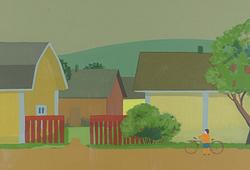Carl Malmsten
A Swedish Grace sofa, Svenska Möbelfabrikerna, Bodafors, 1920s.
Stained birch, ebonised crossbars, padded seat and back covered in a cream fabric. Length 208 cm, depth 65 cm, height 85 cm.
Wear, restored and reupholstered.
Exhibitions
The model was exhibited at Riksvarumässan in Gothenburg 1922-23 and at the Triennale in Milan 1925.
Literature
Gregor Paulsson (ed.), "Svenska Slöjdföreningens Tidskrift", 1921, model illustrated.
Model illustrated in the archives of the Swedish Society of Crafts and Design.
More information
The model was an entry in a competition organised by Svenska Möbelfabrikerna in 1922.
Designer
Carl Malmsten is one of Sweden's most famous furniture designers. Many of his furniture are considered modern design classics, for example, the cane chair "Lilla Åland", the armchair "Farmor", the sofa "Samsas", the cabinet "Herrgården", and the furniture series "Vardag".
Both "Lilla Åland" and "Vardag" adopted the ideals of "beautiful everyday goods" of the 1940s. Their neat shape and frugal design quickly became timeless interior details that we still see in many homes today.
At the beginning of his career, Malmsten interned at various carpentry workshops and studied furniture at Nordiska museet and Skansen. He had his breakthrough in 1916 when he was commissioned to design part of the interior of Stockholm's City Hall.
During his career, Malmsten collaborated with several architects, such as Ragnar Östberg, Ivar Tengbom, and Ferdinand Boberg. He designed furniture for Stockholm's concert hall and Ulriksdal castle. He participated in the now iconic hosing exhibition at Liljevalchs gallery in 1917, where the term "Beautiful everyday goods" was coined.
































































